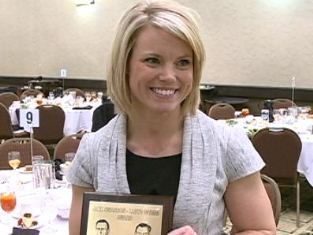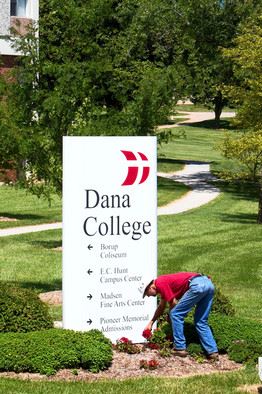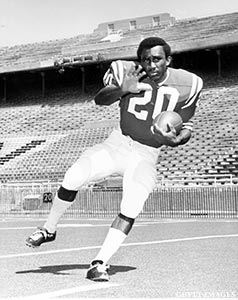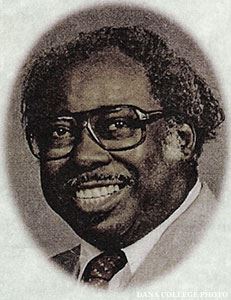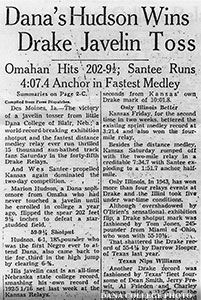|
| Nielsen Honored with Knight of the Order of the Dannebrog Former Dana College Professor, Dr. John Mark Nielsen was awarded the Knight of the Order of the Dannebrog in a ceremony at the Danish Embassy in Washington, D.C. Nielsen is currently the executive director of the national Danish Immigrant Museum in Elk Horn, Iowa. The presentation was made by Danish Ambassador Peter Taskoe-Jensen. The order decorates people who, through selfless deeds, have helped advance the interests of Denmark. Nielsen was in Washington on behalf of the Iowa Museums Association to advocate for museum funding the federal budget. Many deserving people are nominated but few receive the award. The badge is a white enameled silver cross, edged in red, with a royal crown and the monogram of the reigning monarch. Nielsen is the grandson of three Danish immigrants and a native of Blair, Nebraska. He was an English professor at Dana College from 1978 until it’s closing in 2010. He has led the immigrant museum since 2003. Nielsen has also studied and taught in Denmark. He said that the award is a tribute to the museum and the Danish-Americans who started and support it. The museum was founded in 1983 as a nonprofit institution to preserve the culture and history of Danish immigration to the U.S. It is a Danish-style structure sits on a 30-acre site in Elk Horn, Iowa. It houses more than 35,000 artifacts. |
Dana College Alumni, Amber Schlote (Carstens) wins Omaha Police Department’s Officer of the Year Award OMAHA, Neb. — April 23, 2013 Twenty of Omaha’s finest police officers were nominated for the 22nd annual Swanson-Grimm Crime Stoppers Officer of the Year award.The nominations included officers who have saved lives, broke up drug rings and cleared robberies. The winner of the award was Officer Amber Schlote, for her work in tracking down Daniel Mangiameli, a man now convicted of sexually assaulting many boys. “This case took countless hours and it was hard for everybody to know that this guy was out there hurting these kids and everybody was just awesome,” said Schlote. For decades, Daniel Mangiameli got away with preying on young boys, until last year when Schlote was finally able to track him down trying to escape to Mexico. It took countless hours and interviews with traumatized victims.“I had some victims who are adults now who couldn't talk to me. They just literally couldn't say the words,” Schlote said. A child sexual assault case, like this one, can take a toll on everyone.“In all honesty, probably the hardest case I've ever worked. I had a hard time with it,” Schlote said. “They're children and he's been hurting kids for 30 years, more than 30 years, and that's a long time." Mangiameli is convicted of eight assaults and suspected in at least 30 more in five states.“I never expected 195 to 310 years. It was like a weight just lifted that day,” Schlote said. Schlote said she is just glad she could help victims get rid of that living nightmare.“Hopefully it will bring them a sense of closure knowing that justice was served,” she said. |
|
| Ted Bansen: A Gardener Till the End Dana College locked its campus doors Wednesday, June 30, 2010 and life on campus abruptly ended. However, the campus plants (e.g. trees, shrubs, flowers) continued to flourish under the watchful eyes of Ted Bansen, Dana’s arborist/horticulturist. During a conversation with Ted, he once stated, “I’d better cut the grass on top of the campus underground tunnels today because that grass grows faster.” Wearing his safari hat and driving the golf cart across the grounds, Ted patrolled the area. He knew all of the demands of the trees and plants and took pride in caring for his campus; however, he wouldn’t hesitate to stop and talk with you and tell you a positive thought for the day. Ted, at age 45, lost his battle with cancer Friday, September 16, 2011. He is survived by his wife, Margie; son, Thomas, daughter, Ellen; son, Christian, all of Blair. Parents, Lloyd and Ann Bansen, Yamhill, OR; brothers, Pete, Ferndale, CA, Don and Bob both of Yamhill, OR; sister, Lisa Bansen-Harp, Akron, OH; brother, Jon, Monmouth, OR, sister, Kirsten Weigle, St. Michael, MN; Josie Severtson, Potsdam, NY; and 26 nieces and nephews. Funeral Mass was held Wednesday, September 21, 2011 at St. Francis Borgia Catholic Church, Blair, NE. Submitted By Linda (Money ’65) Jorgensen |
Marion Hudson, Timeless Nebraska Legend, Somehow Lost In Time Written by: Kalani Simpson Students headed to the site of a track meet sponsored by Kearney (Neb.)State College one morning in the mid-1950′s. By 9 a.m., a crowd had formed. Marion Hudson was coming to town. The air crackled with anticipation. Hudson’s coach, Wayne Armer, could sense it as he drove up with his team. Then he could see it. “They were waiting for him to get out of the car,” Armer said. This is the way it was in Nebraska in the ’50s. This was who Hudson was.When he came to town, opposing fans fell over themselves to fall over themselves. They waited for him to get out of the car. That was long ago. By the 21st century his name produced only wrinkled foreheads and blank stares — even by officials who had his name listed somewhere deep in their halls of fame. Why was he there, exactly? They couldn’t tell you. He was gone, his legend forgotten. His sand smoothed over. His chalk erased. In the fall of 2005, the Omaha World-Herald, Nebraska’s paper of record, compiled its rankings of the top 100 athletes in state history. Comb through it. Marion Hudson is nowhere to be found. As if all of it had never happened. As if it hadn’t been blared in 30-point ink.As if they hadn’t gathered at 9 in the morning, just waiting for a glimpse. *** Hudson? From Dana College? He couldn’t have been worthy of being mentioned with the likes of Bob Boozer or Johnny Rodgers or Tom Kropp, could he? Not when Hudson did what he had done at little Dana (Neb.) College, a small liberal arts Lutheran church school, instead of at Division I Nebraska, or in the pros. Today, it would have been so simple. If he really was as good as people said, he would have played in the NFL, right? Or he’d have represented the United States in the Olympics, the way so many who saw him compete in track and field still swear he could have done. Right? But a black man in the 1950′s did not inhabit the same world we do. Jackie Robinson was playing baseball, yes, one of a small handful of African Americans in the game. But there was often an unofficial cap on the number of black players on pro rosters in any sport. And they had to make the team in pairs (always an even number; the roommate situation, you see). They weren’t going to be backups or 12th men. Go pro? Alex Meyer, a Nebraska sports historian who befriended Hudson in his later years, who unearthed him from the archives, who brought many of his old accomplishments back to light, said Hudson would simply shrug at the idea. He’d never even considered it. Bounce around from tryout to tryout in hope of making a team as a backup? Train as an amateur for a year or two or three to try to make an Olympic team? No. No, he had his degree. It was time to move on. Tom Osborne, who is on any list of Nebraska’s all-time great athletes, had faced similar competition in his outstanding career at small liberal arts Presbyterian-affiliated Hastings (Neb.) College. But Dr. Tom also had three years as a backup and practice-squad player in the NFL to validate his talent, as memories of his exploits faded and the years rolled on. Osborne, who, it must be noted, would remain famous for coaching Nebraska to three college football national championships, had options, back then. How many black players were on the Washington Redskins when Osborne played for them in 1960 and 1961? None. None. Osborne played for the Redskins. Marion Hudson went out and got a job.And one of the greatest athletes no one has ever heard of was already fading away. *** His athletic career began the way it would end, with a whisper. Marion Hudson, Dana College class of ’56, would sign without fanfare, the way most small-college students do and have always done. It was a quiet night after school, at his kitchen table in hardscrabble north Omaha, surrounded by his parents, and a Dana coach. Hudson died Dec. 8, 2009, after a long illness and a long life. He was 76. He was perhaps the most historically significant figure in his school’s annals, having integrated Dana, as its first African American student. The school had a tradition in those days, said Art Simon, the student president who had led the effort to integrate Dana, of helping “displaced persons” come to Dana. The students would raise a symbolic amount — for room, board books, say — and the college would waive the rest. It was a noble tradition, of which they were proud. Lutheran farm kids were inspired by a speaker from the Urban League who’d described “the racial situation in America.” “That was a whole area that was pretty new to most of us,” Simon said. Art’s brother — Paul Simon, later a U.S. Senator from Illinois and candidate for president of the United States — had pushed for anti-discrimination policies at Dana a few years earlier. But that was the point — regardless of Paul Simon’s policies, the campus was still all white. The students decided this special scholarship should bring the first black student to Dana. The idea was met with great enthusiasm within the student body. “I’m sure it wasn’t unanimous, but it was overwhelming in favor,” said Vaughn Christensen, who had been a junior in 1951. Art Simon was still nervous. He wasn’t sure what the administration’s reaction would be. He went to the school president to ask if Dana would waive the tuition again, but held back a certain key detail. He was told, sure, same deal as always. But then, word of the plan got out. Simon said he was called on the carpet in the president’s office. Eventually, he remembers it, official word from the Board of Regents was that there were already scholarships available — there was no need to give a particular advantage or special privilege for a black student. Well, the students said, fine. They would raise the money themselves. All of it. Christensen gleaned cornfields. He would pick ears up off the ground, to be sold to farmers. Others were with him, classmates, teammates. Others organized car washes, bake sales, that kind of thing. They worked with determination. Someone special was coming to Dana, and they, the students, would be the ones to make it happen. They all did their part. *** Marion Hudson grew up in Omaha, but his dad was in the military, and Hudson spent a good portion of his high school years in Alaska (where he didn’t play football, but once, the story goes, set a world record for sprinting away from a bear). When he returned to Omaha Central for his senior year, he was ruled ineligible for high school sports due to transfer rules. He never got his chance to be a schoolboy legend. Maybe this is why so few remember him, even in his hometown. He practiced with the Central football team anyway, just to be part of it. The story goes that Nebraska high school hall-of-fame coach Frank Smagacz had him on the scout team at offensive guard. Smagacz loved Hudson, loved everything about him, his attitude, his intelligence, the way the kid handled himself. Smagacz coached Omaha Central on Fridays and worked as a referee at Nebraska’s small-college games on Saturday afternoons. He’d heard about Dana’s plan, and he touted Hudson. (By now the fundraising was piling up, and Dana coaches were on board with the idea.) This is the guy you want for this, Smagacz said — he’ll get along with everyone, and, hey, he wants to play sports, too. It might help ease racial tension if he was part of the team. “Frank recommended him as a person,” Vaughn Christensen said. Dana football players would later recall that, as Hudson ran for touchdown after touchdown, Smagacz, wearing officials’ stripes, would mumble to himself, “Oh, yeah, I can spot talent. I had him at guard … ” *** Hudson reported for football practice in the late summer of 1952. His roommate was Jack Lodl, another freshman. Did Hudson seem nervous? Oh, heck no. “We were athletes,” Lodl said. “I hadn’t been around any blacks before, but it sure didn’t seem to make any difference because he had a big smile from the get-go.” There was just something about Marion. Lodl could already tell they were going to be friends. They roomed together for three years. Marion called Lodl “Piston Legs.” Lodl called Marion “Huds.” Hudson punted, kicked, returned kicks and played defense as well as offensive back. In his four years, he had the four highest single-season yards-per-carry averages in Dana history: 8.59 in 1954, 8.26 in 1953, 7.22 in 1952 and 6.34 in 1955. “He glided across the field,” said Jon Petersen, Dana class of 1956. Petersen, a center, said, “I can still visualize being a blocker ahead of him,” the way he hit the hole and was gone. That’s what kind of football player he was. At a game at a small college in Kansas during Hudson’s first year, the Dana team created a stir checking into its hotel. They were told in no uncertain terms to get that (bleep-bleep) out of here. Hudson couldn’t stay. “We were all just flabbergasted,” Christensen said. Hudson could sneak up the back stairs in the daytime, but would have to sleep in the town’s colored boarding house that night. The experience would stay with his teammates for the rest of their lives. Something like that? “Once you walk into it and you’re right there in it, you can’t believe it,” Christensen said. The game itself was even worse. “I’d never heard anyone get called the names he got called in that ballgame,” Christensen said. “Oh yeah, it was unmerciful.” The Vikings were down to their third-string quarterback, with Christensen, a senior — a lineman — calling the plays. Well, Vaughn Christensen did what any lineman would do given the chance to call plays — he called a double reverse. The Vikings were backed up to their own goal line, and by the time Marion got the ball he was in his own end zone. Christensen was a guard, leading the play, and then Marion passed him, and then Marion was gone. All of his teammates were jumping up and down as he ran, whooping now, pumping their fists. They were all running with him as they trailed him. Yes! He was gone, and Dana was sticking it to them. Dana would win. Whenever anyone talks about Marion Hudson and discrimination and the adversity in his life, the way he faced hard times that could have crumbled anyone else, they all use the same phrase: He took it in stride. He embodied it, that day in Kansas, scoring that touchdown. There was Marion Hudson. In stride. *** Hudson didn’t smash or break the color barrier at Dana, contemporaries say, so much as he just kind of slid right in, a seamless fit. He was home. He was perfect. He was humble. He was Huds. There was the time he took Lodl out to a black club in Omaha, and when they first got there, it felt like the “We are going to die” scene from “Animal House.” (Lodl said it ended up being one of the most fun nights he’d ever had.) There was the time he was told by a restaurant that he couldn’t eat in the dining room with the rest of the team, on a road trip. He had to eat his food in the kitchen — where the African American cook gave him the biggest steak he’d ever seen. Was it hard for him? Well, looking back, a few of his white friends said, they now realize it must have been. But at the time, all they knew was that it was all so natural for them. All they knew was that everybody loved him. All they knew was that he was their friend. They saw when he was refused service, when he had to sleep somewhere else, when he didn’t get the summer jobs they got, when something just didn’t feel quite right. Stuff they might not have otherwise even believed was possible had they not seen it happen to a friend. “He had great teammates and stuff that understood and were right therewith him,” Hudson’s wife, Ella, said. That was the thing. It felt like they were right there with him. Hudson loved being a part of the glee club at Dana. He’d grown up in the Baptist church and had an exquisite voice. (Dr. Rodney Wead — Marion’s lifelong friend and Dana’s second black student — noted that Huds could outrun, out-throw and even out-sing every kid in the neighborhood.) He was known on campus for his solo rendition of “Swing Low, Sweet Chariot.” His favorite spiritual was “Little Jesus Boy.” The Dana glee club traveled all over. One man tells a story, of the Dana glee club appearing at his church when he was a teenager. Marion Hudson sung “Swing Low, Sweet Chariot.” The man said this appearance, especially Hudson’s performance, inspired him to attend Dana College. That man? Dr. Myrv Christopherson. He would graduate from Dana. He would go on to serve as Dana’s president for 19 years. *** Hudson graduated with a bachelor’s degree in history and education. By all accounts he was a smart man. He was an affable man. He was a kind man. He was so smart, Ella once said, he could have been a weatherman. “He could have done anything he wanted to,” she said. Yet, it was never easy for him after college. He lived in Minnesota for a while, had a daughter there. But Minnesota did not work out. He returned to Omaha, where at last he met Ella, the love of his life. He adopted her daughter, then they had another. They became foster parents, and adopted the two kids they were taking care of. Then, they adopted two more. Their house was full. Their hearts were full. But Marion was laid off from one job. And layoffs hit him again at another stop. He did anything he could. He sold cars for a while. He sold vacuums door to door. “When times were tough, when he was looking for a job, I’d say he had too much of an education,” Ella said. Yet again, Marion Hudson took it all in stride. At his funeral, a tribute from his daughter Hallie described a father who could make her laugh until she cried, and cooked her special breakfasts when she was feeling down. Marion was a stay-at-home dad for a while, when his youngest kids were little and work was scarce. Their youngest daughter had health problems. He would fix her feeding tubes. “Marion was such a workaholic,” Ella would say. But then, his health problems surfaced, too. He’d had asthma, and diabetes. Strokes would follow. Then doctors had to amputate both legs. Ella tried to hold it together, to handle it all. But at last Marion had to enter a care home, where he spent the last several years of his life. “Marion has been such a fighter. He’s not a quitter,” Ella would say. Lodl said the last time he saw Marion, Huds was better than he had been in a while. But by the time he died in December 2009, Marion had been in poor health for a long, long time. The funeral was a small, quiet affair, a cold December day with snow on the ground. A few old friends telling a few great stories. And the music! Marion music. Swing low, sweet chariot. Coming for to carry me home. *** Let’s remember a little more. This was a road basketball game at Buena Vista (Iowa) College, and Dana was on the fast break. Teammate Larrie Stone let loose with a perfect pass, and Hudson caught it just past the free-throw line. “He just took one giant step,” Stone remembered, and rose, up, up, up, and slammed it like he was throwing a thunderbolt. Stone had never seen anything like that before. He’d never heard anything like that before. “I thought the building was going to come down,” Stone said. The place exploded. In Stone’s memory, this may have lasted several seconds; it may have lasted minutes. The crowd went crazy … for Hudson, a player on the opposing team. That was Hudson. He was so incredible, he could move even opponents to stand and cheer. He wasn’t a great basketball player. He was a good player capable of big games and jaw-dropping feats. He was Omaha World-Herald college player of the week once. He scored 31 points in a game once. He scored 11 points in the last 10 minutes to help Dana win once. He could dunk like no one had ever seen. But he was probably never the best player on his own team. Which was fine. The players had fun together, and the guys loved him. He was the ultimate teammate. He was always the ultimate teammate. “When I entered him in 12 events, he didn’t have too much to say about it,” his track coach Wayne Armer said. “He went out and did it.” Those 12 events came in the 1954 conference championships, and Hudson entered them all, preliminaries in the morning, finals in the afternoon. In his last event of the meet he anchored the 880 relay with a 220 leg and his teammates caught him in a blanket at the finish line — partly to hug him; partly, to hold him up. They wanted to be right there with him. Huds did it all. He ran the 100 in 9.9 seconds, broad jumped more than 24 feet, cleared a 6-foot-4 high jump without aid of the Fosbury Flop technique, and was the first athlete in Nebraska history to throw the javelin more than 200 feet. One tale has him leaping completely over the broad-jump pit. (So why wasn’t Hudson a top prospect for the U.S. Olympic team, the way his contemporaries say he should have been? Well, he was one of the rising stars in the country, in the javelin, one year. Then, javelin technology went through the roof. Dana College got one those “new” javelins. It broke. And that was the school’s budget for new javelins.) He once scored 38 points in a single meet, and in 1955 scored 28 points to lead Dana to the Central Church College Conference track title. That was huge. Dana was then, as always, a small school with very little resources. (So little, in fact, the school shut down in the summer of 2010.) But the Vikings were champions, that day. He picked up the javelin — they mean that literally; one day he just picked it up and threw it — and was the best the state of Nebraska had ever seen. “We were afraid to let Marion throw the javelin in practice,” Armer said, “because he might kill somebody.” Who knew how far it would go? He threw it into history. In 1954 Hudson was the event’s champion at the Drake Relays, when that was arguably the biggest open college track meet in the United States. He outscored all the Big Seven Conference schools combined, that meet. When he won the javelin, the chatter in the stadium was, “Where is Dana? Where is Dana?” After Marion Hudson, everybody knew. *** That was some 57 years ago, and Hudson’s once-legendary exploits have been lost to time. His old friends and teammates can get prickly when asked about him. It angers them that he’s been forgotten, that his legacy was so easily swept aside. There should have been something permanent done to honor him while he was alive, they say, grumbling. But Dana College didn’t do it in time. After years of poor health in a care home, Marion died. Then came word that the football field at Dana would be renamed in Hudson’s honor in the fall of 2010. But the summer before he would have been so memorialized, the small, cash-strapped school shut its doors for good. The stands in the stadium that would have been named for him are empty now, just crickets and whispers and ghosts. The last thing that would have kept his name alive is fading away. Chains on the doors. But this was where Hudson was great, once. This was where a brave man burned bright. Stand now, at the edge of the field, feet on the track. Close your eyes and you can almost hear it. A javelin rides on the wind. |
|

